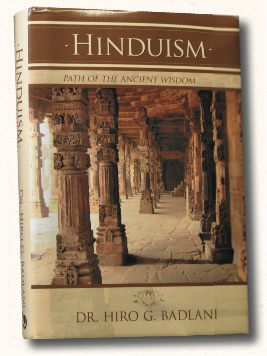BY TARA KATIR
This book by Dr. Hiro G. Badlani is not a scholarly treatise. Rather, it is a non-academic book written by the retired ophthalmologist for two audiences: the youthful Hindu diaspora, and non-Hindus who are interested in learning about Hinduism. Organized in short chapters, just four to nine pages, the book’s topics include Vedas, Upanishads, code of conduct, consciousness, soul, detachment and Goddesses, as well as introductions to the related religions of Sikhism, Jainism and Buddhism.
Badlani offers a discussion of male dominance in ancient Hindu society and women’s roles today. Elsewhere, to illustrate the strength of Hinduism, he quotes American philosopher J. B. Pratt: “The reason for the immortality of the Vedic religion of Hinduism is that while retaining its spiritual identity, it has been changing its outward form in accordance with the demands of the time; and particularly it is the only religion which has been able to meet the challenges of science, which governs the thought and life of the modern age.”
Badlani encourages Hindu youth to hold onto their faith and “adopt these spiritual values in daily activities and fully enrich their lives.” He explains, “Religion, dharma, is basically like a classroom, a school, or a university, where we get the instruction for the moral and virtuous pedagogy. Ultimately, however, it becomes our responsibility to learn and understand these spiritual teachings properly and put them into use in everyday living.” Dr. Badlani’s mini-encyclopedia will be a valuable addition to the library of young Hindus throughout the diaspora.
Hinduism, Path of the Ancient Wisdom, isbn 978-0-595-70183-4 IUniverse, Inc., 1663 Liberty Drive, Bloomington, Indiana 47403, USA, 378 pages, $35.95, www.iuniverse.com [www.iuniverse.com]
AN AMERICAN IN GANDHI’S INDIA
At the turn of the 19th century, a young American Quaker from Philadelphia named Samuel Evans Stokes Jr. set out for India. His goal was to work in a leper home run by the Leprosy Mission in India. Stokes became a well-known Christian missionary who, after careful study of Hindu philosophy, converted to Hinduism in 1932 with his entire family. Asha Sharma, Samuel’s granddaughter, chronicles his unique story in An American in Gandhi’s India, the Biography of Satyanand Stokes.
For twenty-five years, Satyanand (the name he received in India) wrote weekly letters from India to his mother in Philadelphia. In time, the Harmony Hall Letters, a book of the compiled correspondence, was gifted to Asha by her grandmother. Thus began her journey to document her grandfather’s remarkable philosophical and physical journey from America to Kotgarh, in the Simla Hills of Himachal Pradesh, India.
Satyanand was the only American member of the Indian National Congress, the nationalist movement headed by Mahatma Gandhi to free India of British rule. He was also the only American to be arrested by the British, who jailed him for six months on sedition charges.
Satyanand’s efforts to improve the plight of farmers in the Simla hills ultimately freed them from a system of forced labor. An avid farmer himself, he studied fruit tree propagation while on a trip home to Philadelphia and returned to India with saplings of the Red Delicious apple, still today an key crop in Himachal Pradesh.
In the time leading up to his conversion, he wrote, “I am not one of those who take religion so lightly that I can repeat with my lips that to which my spiritual experience does not give assent. I have felt of recent years that I could be honestly a Hindu, whereas I have not for a long time felt I had the right to call myself a Christian.” The conversion itself, described in chapter 20 onwards, was not without controversy, for while Hindus had become Christians, Stokes was the first American Christian to become a Hindu.
An American in Gandhi’s India, by Asha Sharma, isbn 978-0-253-21990-9 Indiana University Press, 607 North Morton Street, Bloomington, IN 47404, USA, 373 pgs, $21.95
AN ENCYCLOPEDIA OF SAIVISM
Swami parmeshwaranand’s three-volume exploration of the world of Saivism is a much more complex presentation than the introductory book on Hinduism reviewed above. This tour de force will appeal to those wanting to delve into the intricacies of Saivite philosophy, history and personalities.
The 117 articles run from six pages for standard topics, such as “Ganas of Siva,” to more than two dozen pages for “Epigraphical Evidence of Siva Cults and Practices.” The text is based on scriptures, the writings of saints, modern archeology and scholarship. The author is particularly adept at explaining the complex systems of philosophers such as Abhinavagupta of Kashmir Saivism. He explores monistic forms of Saivism, such as Abhinavagupta’s, and dualist forms, such as Meykandar’s, but tends to offer a dualist interpretation on key points.
Topics include, Spanda, Absolute Consciousness, Saktipata, Saiva Agamas and Nandikesvara’s Advaita Saivism. In the entry on “Soul and Siva,” Swami writes, “It is because in His inmost essence God Siva is Love that whatever perfection He possesses is a form of love, and that whatever action He performs with respect to souls is a form of grace and springs from His loving care for His creatures. God is Infinite Light, Love and Intelligence.”
The hardback volumes have indexes, but lack other standard helps for the reader, such as a table of contents and page headers to indicate the topic under discussion. Overall, this is a useful resource on Saivism.
Encyclopaedia of the Saivism, isbn-81-7625-427-4 (set) Sarup and Sons, 4740/23, Ansari Road, Darya Ganj, New Delhi, 110002, India. e-mail: sarupandsonsin _@_ hotmail.com, 3 volumes, 895 pgs, rs 3200


